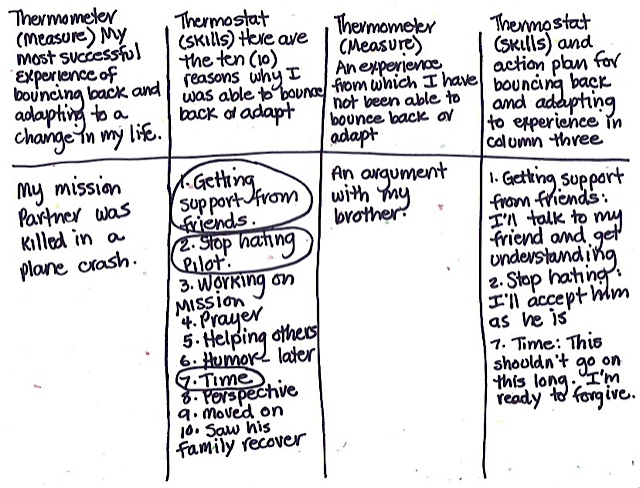
Thoughts on the mind pound like waves on the rocks. Resilience is your ability to bounce back and adapt by utilizing your best thoughts and the best thoughts of others who support your mission.
Check out the video on theinvisiblegorilla.com. Christopher Chabris and Daniel Simons show how concentrating on one idea can keep you from seeing what is right before your eyes. Watch the video and count the number of passes. What did you see? What did you miss? When you allow yourself to be distracted from the mind’s useless chitchat and focus on ways to be resilient and adaptive, your mission will be successful.
Cathy Davidson explains that where you place your attention has an important impact on what you can accomplish in life. So, when adversity strikes, the attention must be distracted to multitasking resilience and adaptation. Most preferable is having a whole team of people working positively towards your mission. (Listen to Cathy’s interview with Anne Strainchamps on To the Best of Our Knowledge, NPR Radio ttbook.org/book/cathy-davidson-how-brain-science-attention-will-change-our-lives.)
Paul Rusesabagina is the perfect example of being distracted from disastrous thoughts to multitasking resilient ideas. A Hutu Interahamwe led group started slaughtering the Tutsi people in Rwanda, April, 1994. After all the other managers fled, Paul became the general manager for the Hotel des Mille Collines. During the genocide, he protected refugees and sheltered them within the walls of the hotel. Without a gun and with great courage, he eventually saved 1,268 people. When asked how he accomplished his mission, he stated, “I remained a hotel manager.” He distracted himself from thoughts of futility and genocide and didn’t stray from being the best hotel manager he could be. This mission included saving people from death.
J. R. Martinez is another example of resilience. In 2003, over forty percent of his body was burned. He was serving as a United States Army infantryman in Iraq. With severe deformity and facial burns, he went on to become a successful actor, entertainer, and speaker. He overcame the initial brain chitchat that his life was over and enlisted himself and others to support his mission of success. He shattered the myth that disfigurement precludes having quality of life.
Thermometer vs. thermostat is the metaphor that represents a resilient way of life. A thermometer measures temperature. The thermostat changes the temperature. You might be shivering out in the cold and lament, “I’m cold, I’m cold.” Thermometer people keep shivering and saying, “I’m cold.”
Thermostat people say, “I’m cold,” and then build a heated structure, install a thermostat, walk inside, and set the thermostat to the right temperature. Next you will hear them proclaim, “I’m cold, but I’ll step inside, raise the setting on the thermostat, and be warm.” Missions end when you focus only on measuring your mission. There must be a structure to make the desired changes. There must be resilience and adaptation to change.
For example, you might think: “I don’t know how to accomplish my mission.” The “thermometer” reads: “Don’t know.” Your mission stops there.
On the other hand, you might again think: “I don’t know how to accomplish my mission.” Being a “thermostat” person, you interrupt that thought and distract yourself with ideas. You might think: “I don’t know how to accomplish my mission, so I’ll create a team, collaborate, set goals, and achieve them until the mission measures up to success.”
In summary, first measure your mission and then create the environment that will sustain success. This is the epitome of being resilient, bouncing back, and adapting.
Quote
“......... Resilience -- if you think of it in terms of the Gold Rush, then you'd be pretty depressed right now because the last nugget of gold would be gone. But the good thing is, with innovation, there isn't a last nugget. Every new thing creates two new questions and two new opportunities.
- Jeff Bezos, Founder Amazon.com
Activity
Materials: A piece of notebook or poster paper, pen, pencil, or markers
Time: Fifteen minutes per person to write and ten minutes per person for discussion.
Instruction:
1. Take out the paper and turn it to landscape view (horizontally). Divide the page into four columns.
2. Label each column:
The first column label: Thermometer (Measure) – My most successful experience of bouncing back and adapting to a change in my life.
The second column label: Thermostat (Skill) – Here are the ten (10) reasons why I was able to bounce back or adapt.
The third column label: Thermometer (Measure) – An experience from which I have not been able to bounce back or adapt.
The fourth column label: Thermostat skills and action plan for bouncing back and adapting to item in column three.
3. Under column one, list the time in your life when you feel you were the most resilient. This might have been a difficult time, a trauma, an adversity, or other event from which you bounced back and adapted.
4. Under column two, list ten (10) reasons why you were able to bounce back from this experience.
5. Under column three list one experience from which you have not been able to bounce back or adapt.
6. Column four is your action plan for bouncing back from what you listed in column three. Column two holds your most precious and valuable assets in overcoming the ill effects of a difficult time, a trauma, adversity, or other event. Circle column two items that could help you bounce back from the experience in column three. In column four, list the column two circled items and give an action plan on how you will apply them to bouncing back and adapting to the experience in column three.
7. Now go around the room and discuss your results with the other participants. If you are alone, you might think about meeting with a friend and sharing this activity and insights. Keep this sheet out for a week and recall your action plan for bouncing back. When you have bounced back, put a big check on the page and file it away.
Note: The next time you experience change, remember that you do have resilience skills. Recall them. They are in column two.
Example: Here is an example of how the activity is done.
Affirmation
I am resilient so I can …… We’d like to hear your story about being resilient. Write your story below.
- « Previous lesson: Purposed: I have a reason for being
- » Next lesson: Identified: I know who I am
